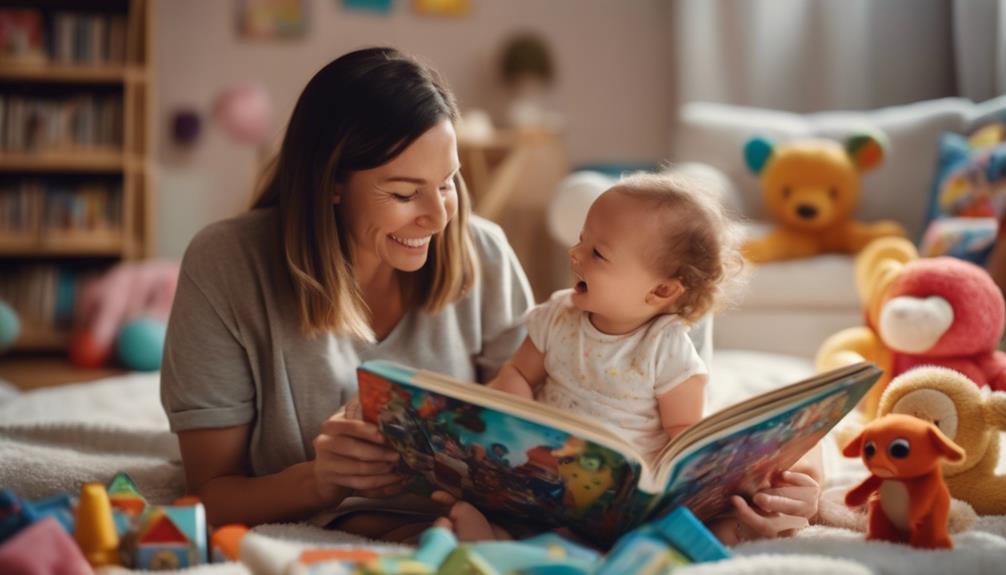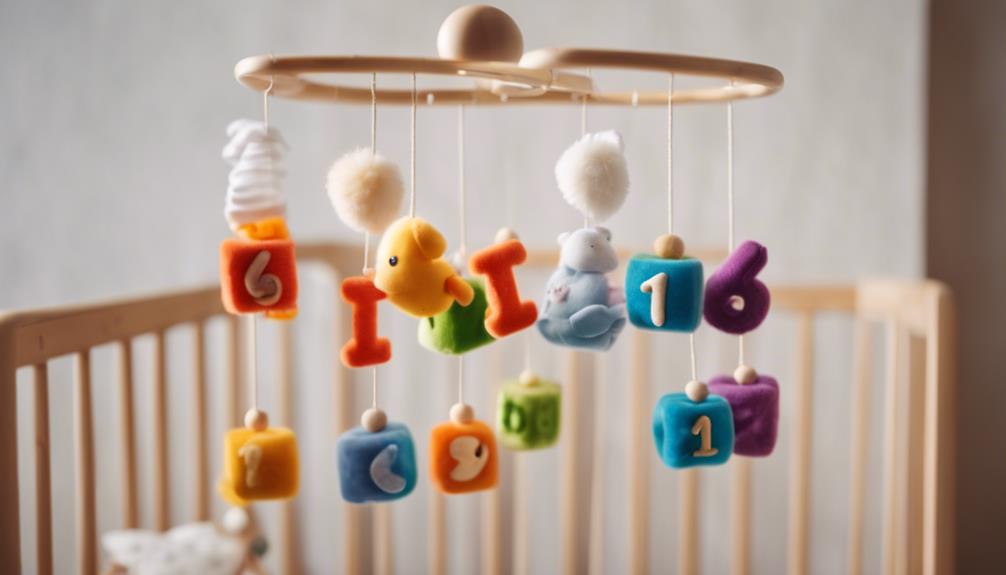Start reading to your baby from the moment they are born to promote optimal development and build a strong parent-child relationship. Babies experience positive effects from reading together, which includes improving language skills and supporting brain growth. By beginning this habit early, even before their first birthday, you are laying the foundation for improved cognitive abilities and more positive interactions with your child. Make sure to incorporate age-appropriate books into your daily routine to engage your baby’s mind and strengthen emotional connections. Introducing reading at an early age helps cultivate a love for books and encourages future literacy skills. To learn more about the benefits and strategies for reading at different ages, explore further information on how to foster a lifelong love for learning.
Key Takeaways
- Start reading to your baby from birth for language and cognitive development.
- Introduce books early to build a strong parent-child bond.
- Reading to newborns with board books aids in attention and literacy skills.
- Reading to babies aged 3-6 months with interactive books enhances cognitive growth.
- Reading to babies aged 6-12 months fosters language skills and curiosity.
Benefits of Reading to Babies
Reading to your baby provides numerous benefits for their language development, cognitive skills, and emotional bonding. The benefits of reading to babies extend beyond just hearing words; it lays the foundation for a robust vocabulary and enhanced literacy skills in the future.
Research shows that starting shared reading from birth positively impacts brain development, setting the stage for improved cognitive functioning. Engaging in shared reading with your baby not only fosters language skills but also predicts gentler parenting behaviors and strengthens the bond between parent and child.
It's essential to start reading to your baby early, ideally before their first birthday, to maximize the developmental advantages that reading offers. By incorporating reading into your daily routine, you aren't only stimulating your baby's mind but also nurturing a strong emotional connection that will benefit them throughout their life.
Reading to Newborns

For optimal developmental benefits, consider introducing books to your newborn early on. Reading to babies from birth is essential for their language and cognitive growth. Research has shown that shared reading during infancy not only fosters a stronger parent-child relationship but also predicts gentler parenting styles.
Board books are a great option for babies, as they're designed to be short and engaging, making it easy to incorporate reading into your daily routine. Starting to read to your baby early helps establish a positive association with books and storytelling, setting a foundation for a lifelong love of reading.
The simplicity of board books is perfect for capturing your newborn's attention and promoting early literacy skills. By introducing reading to your baby from the very beginning, you're providing them with a valuable head start in language development and nurturing a bond through the joy of storytelling.
Reading to Babies Ages 3-6 Months

Moreover, incorporating board books with interactive features and textures to engage babies ages 3-6 months in early literacy and cognitive development can have a significant impact. Reading aloud to babies in this age group using books specifically designed for their developmental stage can profoundly influence their communication skills and overall brain development.
Interactive elements such as touch-and-feel textures not only enhance sensory experiences but also help babies explore the world around them through tactile stimulation. These early reading sessions can foster a love for books and storytelling, laying a strong foundation for future reading habits.
Additionally, regular reading sessions with babies ages 3-6 months can strengthen the bond between parents and their little ones, creating a nurturing environment for growth and learning. By introducing books for babies with interactive features at an early age, you're providing them with valuable opportunities to benefit from the many advantages of early reading.
Reading to Babies Ages 6-12 Months

Reading to babies aged 6-12 months is a wonderful way to enhance their language skills and cognitive development. During this stage, babies become more interactive, pointing at pictures and making sounds while engaging with books.
Choosing interactive board books with textures and bright colors can further stimulate their senses and curiosity.
Reading Routine Benefits
Establishing a consistent reading routine with your baby aged 6-12 months can greatly benefit their cognitive development and language skills. Reading to your baby at this stage isn't only a bonding experience but also an essential way to stimulate their growing mind.
Babies between 6-12 months thrive on interactive books that offer textures, flaps, and colorful illustrations. These elements help capture their attention and engage them in the reading process, aiding in the development of language skills.
By incorporating a reading routine into your daily activities, you're fostering a love for books and stories in your little one. Introducing books with simple concepts, such as one object or person per page, can further enhance their understanding and keep them interested.
Interactive Book Choices
When reading to babies aged 6-12 months, opt for interactive books that feature textures, flaps, and mirrors to engage their developing senses and motor skills effectively. These touch and feel books provide a hands-on experience that captivates your little one's attention and encourages exploration.
At this stage, babies enjoy interacting with books that allow them to touch different textures, lift flaps to reveal surprises, and even discover themselves in mirrors. Books presenting simple concepts with one clear object or person per page are beneficial for babies aged 6-12 months, as they help focus their attention and aid in understanding basic ideas.
To enhance engagement during reading sessions, try acting out the story, making sound effects, and involving your baby in the storytelling process. Encourage them to point to objects in the book and respond to simple questions, fostering their comprehension and communication skills.
Choosing interactive books tailored to their age group can make reading a fun and educational experience for both you and your baby.
Language Development Milestones
As babies aged 6-12 months are read to, they begin to recognize familiar words and may respond with babbling. Reading to your baby during this critical first year aids in their language development, helping them build pre-literacy skills and expand their vocabulary. Babies at this age start to grasp simple stories and may exhibit interest in turning pages or pointing at pictures, showing signs of cognitive growth. It is essential to read aloud to your baby to foster a love for books and stimulate their curiosity about the world around them. Utilizing a variety of books, including interactive ones with textures, flaps, or sounds, can enhance sensory exploration and engagement with the material. By incorporating reading into your daily routine, you are laying a strong foundation for your baby's language skills and overall development.
| Language Development Milestones |
|---|
| Recognition of familiar words |
| Babbling response to reading |
| Understanding simple stories |
| Interest in turning pages |
| Stimulation of sensory exploration |
Reading to Toddlers

To enhance your toddler's cognitive development and pre-literacy skills, reading to them regularly is vital. Reading to toddlers not only builds their vocabulary but also boosts their pre-literacy skills, comprehension, and fluency.
Encouraging toddlers to participate in reading by naming objects or asking questions can greatly enhance their cognitive development. It's essential to make reading fun for toddlers by using engaging books, funny voices, and interactive elements. This fosters a love for reading and learning while improving their listening skills and imagination.
Furthermore, the benefits of reading to toddlers extend to improving their memory development. Rereading familiar books can aid in reinforcing learning through repetition and help toddlers make connections between spoken and written words.
Age-by-Age Guide to Reading

When it comes to reading to your baby, understanding age-appropriate practices is key. From infant reading habits to toddler storytime routines, tailoring your approach can make a significant impact.
Infant Reading Habits
Begin reading to your baby from the very start to cultivate a love for books and enhance language development. Reading to newborns is key in building a positive association with books and storytelling right from the beginning. It is never too early to start engaging your child with baby books and children's books to instill a love of reading. To help guide you through the different stages of infancy, here's an age-by-age guide to reading to your baby:
| Age Range | Reading Strategies |
|---|---|
| 0-6 months | Use age-appropriate books and interactive elements to engage babies. |
| 7-12 months | Introduce books with simple stories and encourage participation. |
| 13-24 months | Stick to familiar books and incorporate repetition to aid learning. |
Toddler Storytime Routines
For toddlers aged 7 to 12 months, engage them in storytime by using books with one object or person per page and encouraging interactive participation through acting out the story. As your little one approaches their first birthday, choose colorful board books that capture their attention with simple images and minimal text. These books help in developing joint attention and fostering a love for reading early on.
Toddlers aged 13 to 18 months benefit from slightly more complex books with a sentence or two per page, promoting participation and interaction during storytime. As they grow older, around 19 to 24 months, introduce familiar books with repetition to provide reassurance and aid in their learning and comprehension. Encourage their engagement by pausing to discuss the plot, asking questions, and naming objects in the books.
More Book Picks for Infants

Explore board books with engaging rhymes and interactive features for a delightful reading experience with your infant. Look for books specifically designed for infants with textures, mirrors, and peek-a-boo elements. These interactive elements can captivate your little one's attention and make reading time a fun sensory experience.
Opt for board books that have contrasting colors and simple illustrations, as these can help engage newborns and promote visual stimulation. Additionally, selecting sturdy books made of durable materials is essential to withstand your infant's exploration and occasional chewing habits.
When choosing books, prioritize ones that encourage interaction and sensory exploration to stimulate your infant's developing senses. By incorporating these features into your book selections, you can create an enriching and enjoyable reading environment for your infant, fostering a love for books and early literacy skills from a young age.
Raising a Reader

To raise a reader, engage your baby in daily reading sessions to foster a lifelong love for books and learning. By starting early and making reading a part of your routine, you can introduce books as a source of joy and knowledge for your young children.
When reading to your baby, make sure to keep them engaged by using expressive tones and gestures to bring the story to life. Prioritize paying attention to the words you're saying and emphasize key points to help your baby understand and retain information.
Regular reading sessions not only help in language development but also serve as bonding moments that enhance parent-child interaction. As your baby grows, continue to choose age-appropriate books that capture their interest and expand their vocabulary.
Frequently Asked Questions
When Should I Start Reading to My Infant?
Start reading to your infant as early as possible, even before their first birthday. Reading from birth boosts vocabulary and reading habits in older children. It aids motor skills, emotional bonds, and sets a lifelong love for learning.
When Should I Start Reading to My Unborn Baby?
Start reading to your unborn baby as early as the second trimester, around 16-20 weeks of pregnancy. They can hear sounds outside the womb by 18-20 weeks, and it helps familiarize them with your voice and bond.
When Should You Read When You Have a Baby?
Start reading to your baby as early as possible. Daily reading sessions can boost language skills and cognitive development. Research indicates that babies benefit from exposure to books even before birth. Embrace the power of storytelling!
What Is the Earliest Age to Start Reading?
Start reading to your little one as early as possible. Introducing books from the beginning can boost language skills and cognitive development. Reading even before birth can positively impact brain growth. Make it a routine!
Conclusion
To sum up, reading to your baby from a young age provides numerous benefits for their development.
Remember the old adage, 'You're never too young to start learning.'
By incorporating reading into your daily routine, you can help your child build a strong foundation for literacy and language skills.
Whether you're reading to a newborn or a toddler, the important thing is to make it a consistent and enjoyable experience.
So grab a book and start reading today!










